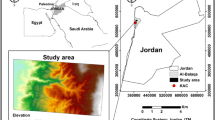Abstract
Digital elevation models (DEMs) can be captured and analysed by various methods. Elevation capturing with RTK-GPS and airborne laser scanning is presented and evaluated in terms of height accuracy of raw data and interpolated DEMs for study sites in Sweden and Germany. Applications for precision agriculture are based on the connection of land surface and the movement of water in the landscape. Three methods of deriving potential flow accumulation from DEMs are discussed. Results indicate that the Topographic Wetness Index can be used to assess the pattern of potential soil moisture on a field and changes in soil texture caused by erosion processes. The quality of the soil moisture assessment varies with both flow algorithm and terrain characteristics. Correlations up to r 2 = 0.64 were found. Best results were obtained on undulating farmland using the DEMON algorithm and a formbased approach. However, in areas with low relief, the concept did not lead to valuable soil moisture maps.
Similar content being viewed by others
References
Afyuni, M. M., Cassel, D. K. and Robarge, W. P. 1993. Effect of landscape position on soil water and corn silage yield. Soil Science Society of America Journal 57, 1573-1580.
Barling, R. D., Moore, I. D. and Grayson, R. B. 1994. A quasi-dynamic wetness index for characterizing the spatial distribution of zones of surface saturation and soil water content. Water Resources Research 30(4), 1029-1044.
Beven, K. J. and Kirkby, M. 1979. A physically-based, variable contributing area model of basin hydrology. Hydrological Sciences Bulletin 24, 43-69.
Bill, R. 1999. Grundlagen der Geo-Informationssysteme. Band 2: Analysen, Anwendungen und neue Entwicklungen [Basics of Geo-Information Systems, Vol 2: Analysis, Applications and New Developments] (Wichmann Verlag, Heidelberg, Germany), p. 108.
Bishop, T. F. A. and McBratney, A. B. 2002, March. Creating Field Extent Digital Elevation Models for Precision Agriculture. Precision Agriculture 3(1), 37-46.
Bobert, J., Schmidt, F., Gebbers, R. I. B., Selige, T. and Schmidhalter, U. 2001. Estimating soil moisture distribution for crop management practices with capacitance probes, EM-38 and digital terrain analysis. In: Third European Conference on Precision Agriculture, edited by G. Grenier and S. Blackmore (agro Montpellier, France), pp. 349-354.
Burrough, P. A. and McDonnell, R. A. 1998, Principles of Geographical Information Systems (Oxford University Press, Oxford, UK).
Burrough, P. A., Van Gaans, P. F. M. and MacMillan, R. A. 2000. High-resolution landform classification using fuzzy k-means. Journal for Fuzzy Sets and Systems 113(1), 37-52.
Costa-Cabral, M. C. and Burges, S. J. 1994. Digital elevation model networks (DEMON): A model of flow over hillslopes for computation of contributing and dispersal areas. Water Resources Research 30(6), 1681-1692.
Gallant, J. C. and Wilson, J. 1996. TAPES-G: A grid-based terrain analysis program for the environmental sciences. Computers & Geosciences 22(7), 713-722.
Hofmann-Wellenhof, B., Lichtenegger, H. and Collins, J. 1997. GPS. Theory and Practice, 4th, revised edition (Springer Verlag, Berlin; Wien; New York).
Jenson, S. K. and Domingue, J. O. 1988. Extracting topographic structure from digital elevation data for geographic information system analysis. Photogrammetric Engineering and Remote Sensing 54(11), 1593-1600.
Lück, E. and Eisenreich, M. 2001. Electrical conductivity mapping for precision agriculture. In: Third European Conference on Precision Agriculture, edited by G. Grenier and S. Blackmore (agro Montpellier, France), pp. 425-429.
Moore, I. D., Gessler, P., Nielsen, G. and Peterson, G. 1993. Soil attribute prediction using terrain analysis. Soil Science Society of America Journal 57, 443-452.
Nolan, S. C., Goddard, T. W., Lohstraeter, G. and Coen, G. M. 2000. Assessing management units on rolling topography. In: Precision Agriculture: Proc. (on CD) 5th International Conference, edited by P. C. Robert, R. H. Rust and W. E. Larson (ASA, CSSA, SSSA, Madison, WI, USA).
Nugteren, A. and Robert, P. 1999. Usefulness and feasibility of high accuracy digital elevation models for precision management. In: Precision Agriculture' 99. Proceedings of the 2nd European Conference on Precision Agriculture, edited by J. V. Stafford (Sheffield Academic Press, Sheffield, UK), pp. 561-569.
Persson, A. and Pilesjö, P. 2000. Digital elevation models in precision farming. Sensitivity tests of different sampling schemes and interpolation algorithms for the surface generation. In: Proceedings of the Second International Conference on Geospatial Information in Agriculture and Forestry, published by Veridian ERIM International Conferences (Ann Arbor, MI, USA), pp. 214-221.
Pilesjö, P., Zhou, Q. and Harrie, L. 1998. Estimating flow distribution over digital elevation models using a form-based algorithm. Geographic Information Sciences 4, 44-51.
Russell, D. C., Smith, M. J., Dodson, A. H., Steven, M. D. and Stafford, J. V. 2000, May 1–4. DEM creation using GPS for use in precision farming. In: Proceedings GNSS 2000 Conference, Edinburgh, Royal Institute of Navigation.
Schmidt, F. 2001. Generation and analysis of digital terrain models for agricultural applications. In: Third European Conference on Precision Agriculture, edited by G. Grenier and S. Blackmore (agro Montpellier, France), pp. 109-114.
Stone, J. R., Gilliam, J. W., Cassel, D. K., Daniels, R. B., Nelson L. A. and Kleiss, H. J. 1985. Effect of erosion and landscape position on the productivity of piedmont soils. Soil Science of America Journal 49, 987-991.
Webster, R. and Oliver, M. A. 1990. Statistical Methods in Land and Resource Survey (Oxford University Press, Oxford, UK).
Wilson, J. P. and Gallant, J. C. (Eds.). 2000. Terrain Analysis. Principles and Applications (John Wiley & Sons, New York, USA).
Yao, H. and Clark, R. L. 2000. Evaluation of sub-meter and 2 to 5 meter accuracy GPS receivers to develop digital elevation models. Precision Agriculture 2(2), 189-200.
Author information
Authors and Affiliations
Rights and permissions
About this article
Cite this article
Schmidt, F., Persson, A. Comparison of DEM Data Capture and Topographic Wetness Indices. Precision Agriculture 4, 179–192 (2003). https://doi.org/10.1023/A:1024509322709
Issue Date:
DOI: https://doi.org/10.1023/A:1024509322709




